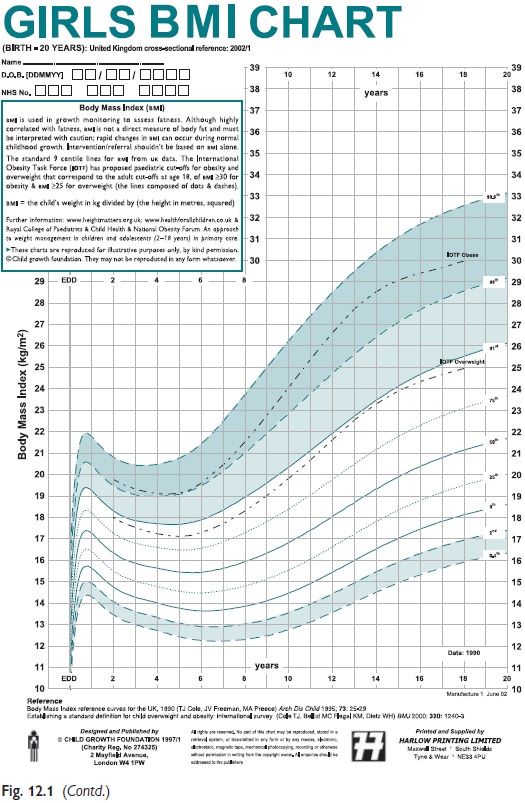Chapter: Paediatrics: Endocrinology and diabetes
Paediatrics: Obesity
Obesity
This has become an important
public health problem, which has achieved epidemic levels in the developed
world. In the UK approximately 20% of children and adolescents are either
overweight or obese. Obesity in childhood strongly predicts obesity in
adulthood. Obesity is an impor-tant risk factor for the development of
life-threatening disease in later life, including type 2 diabetes mellitus
(T2DM), hypertension, cardiovascular disease, and cancer.
Definition and diagnosis
Obesity implies increased central
(abdominal) fat mass, and can be quanti-fied using a number of clinical
surrogate markers. BMI is the most conven-ient indicator of body fat mass (see
Fig. 12.1).


BMI = weight (kg)/[height (m)]2
┬Ę
Overweight: BMI >91st centile, wt <98th
centile
┬Ę
Obese: BMI >98th centile
Other measures of obesity include:
┬Ę
waist
circumference;
┬Ę
waist:hip
ratio.
Epidemiology
The worldwide increase in
incidence in obesity has been mainly observed in Western countries and in other
developed societies. Risk factors for the development of obesity include the
following:
┬Ę Parental/family history of
obesity.
ŌĆó Afro-Caribbean/IndianŌĆōAsian ethnic origins.
┬Ę Catch-up
growth (weight) in early childhood (0ŌĆō2yrs): infants born small for
gestational age who demonstrate significant weight catch up (>2SDs) in first
2yrs of life.
Causes
So-called idiopathic (or ŌĆśsimpleŌĆÖ)
obesity is by far the commonest cause of obesity accounting for up to 95% of
cases. It is multifactorial in origin and represents an imbalance in normal
nutritionalŌĆōenvironmentalŌĆōgene interaction, whereby daily calorie (energy)
intake exceeds the amount of calories (energy) expended:
┬Ę genetic predisposition (energy
conservation);
┬Ę increasingly sedentary lifestyle
(energy expenditure);
┬Ę increasing consumption and
availability of high energy foods.
Obesity may be associated with
other identifiable underlying pathological conditions.
Endocrine (rare)
┬ĘHypothyroidism.
┬ĘCushingŌĆÖs syndrome/disease.
┬ĘGrowth hormone deficiency.
┬ĘPseudohypoparathyroidism.
┬ĘPolycystic ovarian syndrome.
┬ĘAcquired hypothalamic injury, i.e.
CNS tumours and/ or surgery resulting in disruption to the neuroendocrine
pathways regulating appetite and satiety.
Genetic
Obesity is a recognized feature
characterizing the phenotype of a number of genetic syndromes.
┬ĘPraderŌĆōWilli syndrome.
┬ĘBardetŌĆōBiedl syndrome.
┬ĘMonogenic causes: leptin
deficiency (rare); melanocortin 4 receptor gene (5ŌĆō6% of all causes).
Related Topics